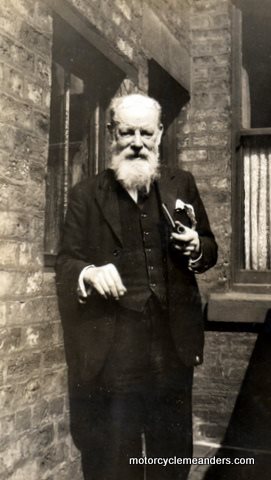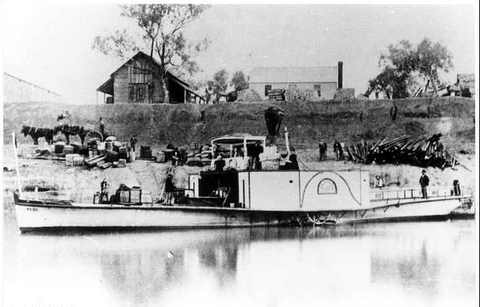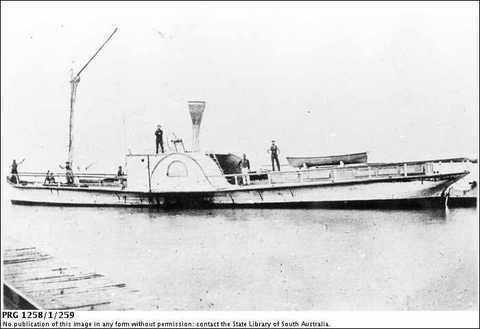
 |
|
William Crick of Wentworth
This page provides some information about William Crick, who is my great grandfather. I took the opportunity, when passing through Wentworth on my Big Trip North, to do some research on him. I knew he had lived and worked in the area. I would like to thank the following for their help in obtaining information for this page: Leanne Watmuff, Library Technician Local Studies, Wentworth Shire Library; Jeanette Hope, River Junction Research; Peter Vail, Great Great Grandson of William Crick.
The central theme of the oral history about my great grandfather, William Crick, that I had been told for many years, was that he ran wool barges along the Darling River between Wentworth and Bourke; that he had a stage coach run (it was always assumed to be between the same two towns); and that Cobb and Co moved in as a competitor, only to drop out because William could subsidise his coach travel with his wool barges. It would seem that much of this oral history is substantially well founded, but had collected a few embellishments and inaccuracies along the way. In addition to the oral history, I had come across references to William Crick in books dealing with the life of his more famous or notorious son, William Patrick Crick – more commonly known as W P Crick or Paddy Crick. These had usually only noted that William Crick has arrived from England and had settled in Truro in South Australia, before moving to Wentworth. He later moved to the Dubbo area, eventually ending up in Darlinghurst (Sydney), where he died. He is buried in Waverley cemetery. He married Margaret Mungovan, who obviously is my great grandmother. She also died in Sydney and is buried with William. William Crick – Origins and Early Days
On my first foray into researching this, I came into contact with a Mary Wilson, who lives in Broken Hill and had done a lot of research into the history of Menindee and the area around the ‘Great Darling Anabranch’. The Great Darling Anabranch flows from the Darling just south of Menindee and joins the Murray just after its junctions with the Darling. One of the sources that refers to William Crick in a couple of contexts is a book called ‘Bushmen of the Great Anabranch’. I learnt, at this stage, that William was more noted as a mail contractor, including a mail run from Wentworth to Bourke, and, as far as I can gather, his name was given to the park in that capacity. A later stop-over in Wentworth (August 2009), as part of my Big Trip North, allowed me to dig up quite a bit more about William. This was as a result of a day’s research in the local library with the help of their chief local history expert. I found entries in material produced by the SA Genealogy and Heraldry Society that read as follows: Crick, William. b. c 1824, Bkm Eng, arr 1857 Carnatic, occ farm labourer, rel C/E, m by 1857 Mary b. c 1827. Crick, William. d. After 1867, occ mail contractor, res Truro, rel R/C, m 3/2/1858 Adelaide, Margaret nee Mungovan. Ch John (1859- ), William Patrick (1862-1908), Jas Henry (1864- ). In less cryptic terms, the first entry says that William Crick was born around 1824 in Buckinghamshire, England (we would say UK now). He arrived in Australia in 1857 on a ship called ‘Carnatic’. His occupation was given as ‘farm labourer’. His religion was Church of England. By 1857, he had married Mary, who was born about 1827. The second entry says that William Crick died after 1867. His occupation was ‘mail contractor’. His place of residence was Truro (SA). His religion was Roman Catholic. He married Margaret Mungovan in Adelaide on 3 February 1858. His children were John (born 1859), William Patrick (1862-1908) and James Henry (born 1864). The shipping list for the Carnatic, which arrived at Port Adelaide (South Australia) on 24 January 1857, includes in the ‘family’ category: William Crick, aged 38, farm labourer, place of residence Buckinghamshire, married to Mary, aged 30. The shipping list for another ship, not mentioned in the SA G and H Society entry, the Sibella, which arrived at Port Adelaide (South Australia) on 16 March 1852, has the following entries in the ‘single men and boys’ category:
William’s memorial card says that he died on 27 January 1920, aged 88 years. His Death Certificate says that he died on 27 January 1920, aged 87 years. So, the William Crick who was my great grandfather was obviously the one who arrived on the Sibella.
His death certificate says he was born in Kirtling, England; and that his father was a farm labourer, whose name was Thomas. Kirtling is in Cambridgeshire, which accords with Cambridge being listed as his place of residence on the Sibella shipping list. It also says he was 22 when he married Margaret Mungovan in Adelaide. Margaret’s death certificate says she was 25 at the time. On the basis of William’s age, that suggests they were married in 1854 or 1855. This also works if you count forward from his year of birth. However, the genealogy entry above gives a very specific date of 2 February 1858. Both certificates put the birth of their eldest child (John) at around 1860, which is consistent with the genealogy entry that gives 1859 as his year of birth. The two death certificates coincide in listing all their living children: John, James, Elizabeth, Thomas, Ellen and Eva. William’s notes “one male deceased”. Margaret’s notes “one male [and] one female deceased”. The male is obviously William Patrick (WP Crick). Perhaps, Margaret had a child who died before she and William were married. I find it interesting that William made the long and undoubtedly daunting trip at the age of 19, with, presumably, little money, no education to speak of and an unknown future. He would have had to find work quickly to survive. From the information below, he would seem to have developed jobs and enterprises in a fairly short space of time. Another interesting fact from the Sibella shipping list is that he was accompanied by Thomas Crick, aged 20. He was William’s brother who gets mentioned in the information below. We know something about his life and death. Charles was a cousin to William and Thomas. William Crick, the Mail Contractor Another find in the Wentworth library was a copy of an extensive article in ‘The Murray Pioneer’ (a newspaper) dated 21 December 1923. The article was written by Walter Ogilvy and it retold stories from the time, as told to him by John George Coombs, described as “bushman, stockman and mail coach driver”. The introduction to the article refers to John Coombs, later referred to as Jack, as someone who “for close on seventy years has lived and worked in the river country between Wentworth and Blanchetown.”
The following points are Jack’s memories: Jack says that William Crick, whom he refers to as Bill, was the first man who drove mail on the Murray. Leaving Adelaide, his coach passed through Truro, then onto Blanchetown. Passing round the great nor’west bend, it called at Overland Corner and Bookmark, and so up river to Wentworth. Jack is also recorded as saying that a pack horse carried the mail between Blanchetown and Wentworth. The letters and papers would only weigh a few pounds. At the Anabranch, the natives would put the mails across in one of their canoes, and Crick would swim his horses behind. The journey would take three and a half to four days; and Crick rode the track for between six and seven years. According to Jack, this was the very first mail service on the Murray. Jack said that the second mail service was carried in a kind of half breed sulky, and George Raynor, one of the Lake Victoria stockmen, took the job on for Crick, who was still the contractor. Hugging the river all the way, Raynor drove from Wentworth to Overland Corner, where Harry Brand, crossing at Wrigley’s, would drive into Blanchetown. This service was maintained until Cobb and Co obtained the contract and came onto the road. Cobb and Co held the road for six years, when Bill Crick got the contract again. Cobb and Co ran opposition coaches to Crick, but they only lasted some three months. The big firm became tired of the game and eventually pulled out, selling all their best horses to Crick. Jack had a bit to say about drivers and whom they drove for. He recalled that in 1874, Harry Pegler had the mails running between Blanchetown and Wentworth. (This becomes relevant later in this story.)
Maxine Withers, in her book “Bushmen of the Great Anabranch” says that the Moorna Post Office was established at the Junction on 22 February 1855. Moorna was a settlement along the Murray about 30kms west of the junction of the Murray and Darling rivers, where present day Wentworth is situated. The following is an extract from an article on Moorna by Jeanette Hope: “In 1854, a watch-house is said to have been erected [at Moorna], and a Court of Petty Sessions appointed. There was also a police force, of two European and five local Aboriginal troopers. In 1855, the Moorna Post Office was established, but it appears that this was actually located at the junction of the Murray and Darling Rivers. In 1859, a survey laid out the town of Moorna and the next year town lots were auctioned. Only 14 lots were sold, because already Moorna was being overshadowed by Wentworth, more advantageously located at the junction of the Murray and Darling Rivers. The Commissioner and the Court were soon transferred to Wentworth, and Moorna Town died.” It was to and from the Moorna PO at the Junction that mail was delivered and despatched. A plaque on a wall in the main street of Wentworth says “a shed on this site was named Wentworth Post Office on 30 June 1860. Prior to this date it had been known as Moorna.” This reflects the fact that by 1860, Wentworth (at the junction) had become the key location for business and settlers. The plaque also notes that “Andrew McClymont was Postmaster.” Withers’ book notes that Andrew McClymont became postmaster in 1857 (at the Moorna Post Office at the Junction).
Later in her book, Withers writes: William Crick carried the Darling mails from Adelaide. On 5 May 1870, the South Australian Register reported: “Cob and Co’s opposition coach (bought from Rounsevell on 13 December 1861) has ceased running on the route from Freeling to Wentworth. Mr Crick, the mail contractor, will have therefore the road without further opposition. His turnout, both conveyance and teams are deserving of great praise, and further, he is entitled to much credit for his punctuality.” She also records that “at the beginning of 1873, the pioneer John Conrick, overlanding with cattle from Warrnambol to Cooper’s Creek 1200 miles away, travelled up the Darling and met William Crick on the track.” Withers spends some time describing Conrick’s journey, drawing on his diary, which makes very interesting reading. His diary records “On the Anabranch, we met a mailman named Crick... Crick had a packhorse and one saddlehorse, and he had 300 miles to ride between Wentworth and Wilcannia...We sent out letters by Crick.” Trying to piece all this together, the following emerges: Around 1857-58, William Crick was settled in Truro. William would seem to have been involved in mail runs to and from the ‘Moorna PO’, while it was still called that, although physically located in Wentworth; and also after its name changed to Wentworth PO. He was still engaged on the Adelaide-Wentworth route in 1870. If, extrapolating from Jack Coombs’ recollections, Cobb and Co pulled out of competition with William Crick three months after he regained the contract, Wiliam’s getting the contract back must have been around February 1870. If Cobb and Co had the contract for 6 years before William Crick got it back, he must have had it up until 1864. Coombs also recollects that, under Wiliam Crick’s first contract, he ran the road for six to seven years. That means he must have started about 1858. It would seem more likely that the first contract of carrying mail between Adelaide and Wentworth was by pack horse. This accords with several of Coombs’ recollections and a statement in Withers’ book, notwithstanding Coombs’ also referring to ‘the coach‘ passing through Truro and Blanchetown, and up the river to Wentworth. I wondered if there wasn’t possibly a coach from Adelaide to Blanchetown, where William might have collected the mail for transport by pack hose to Wentworth. It’s hard to imagine that William would have had the capital to buy coaches too soon after his arrival in Australia as a farm labourer. That’ll need further investigation. It might have been that Cobb and Co replaced William around 1864 because they proposed coach travel. After that, William might have set out to position himself to win back the contract in 1870. But Coombs refers to other contractors around 1874. And the pioneer Conrick met Crick on a packhorse run from Wentworth to Wilcannia in 1873. So what happened to his coach contract and the horses he bought from Cobb and Co around 1870? Then there’s the reference to Freeling. The only reference I came across to Freeling was in the South Australian Register quoted in Withers’ book reporting that Cobb and Co had ceased running on the route from Feeling to Wentworth. It would have been around 1873 – and for however long William trekked north from Wentworth with mail – that he came to pass through Menindee. There are still some gaps in all this, at least, in my mind. If anyone reading this has some answers, I’d love to hear from them. William Crick, the Wool Transporter
I didn’t come across any specific references to wool, but I understand that the river trade was largely transporting wool down the Darling to Wentworth. I gather there were instances, when the river spilled its banks across the flood plains, that the small steamers could cross the plains and collect wool directly from the shearing sheds. There were other times when steamers and barges were stranded for months when the river dried up.
The PS Blanche was built in 1869 by Gordon and Wallace in Goolwa. The engine came from Goolwa Foundry. Its official number was 55603. It was broken up in 1909.
There’s still a lot more to follow up if I get the time, opportunity and inspiration.... RC 22 August 2009, Wilpena. Revised 24 November 2009, Canberra.
|
||||||||||||||||||||||||

 There was a paper with a lot of information about the departures and arrivals of the PS Blanche. Unfortunately, the records don’t start until 1882, some five years after William Crick sold it. But they do provide an insight into the trips it did and its cargo from 1882 to 1887. From 1882 to 1883, it had a busy schedule between Wentworth and Morgan, with many departures recorded as “for the Darling” and arrivals “from the Darling.” There’s a record in 1885 having it arrive “from the Murrumbidgee.” There are references to it transporting wool “from the Darling.” There’s a reference in 1888 to a Mildura Cultivator, Mr P McLaren, purchasing a retired steamer –the Blanche. He caulked and patched her up and sailed her to Mildura.
There was a paper with a lot of information about the departures and arrivals of the PS Blanche. Unfortunately, the records don’t start until 1882, some five years after William Crick sold it. But they do provide an insight into the trips it did and its cargo from 1882 to 1887. From 1882 to 1883, it had a busy schedule between Wentworth and Morgan, with many departures recorded as “for the Darling” and arrivals “from the Darling.” There’s a record in 1885 having it arrive “from the Murrumbidgee.” There are references to it transporting wool “from the Darling.” There’s a reference in 1888 to a Mildura Cultivator, Mr P McLaren, purchasing a retired steamer –the Blanche. He caulked and patched her up and sailed her to Mildura.  William’s ownership of the Blanche and Morning Star seems to have started around the same time he was transporting mail north from Wentworth to Wilcannia – and possibly as far as Bourke. Perhaps his ownership of the steamer and barge was an investment and he occupied himself with his mail contract. Perhaps he was over mail contracting by then.
William’s ownership of the Blanche and Morning Star seems to have started around the same time he was transporting mail north from Wentworth to Wilcannia – and possibly as far as Bourke. Perhaps his ownership of the steamer and barge was an investment and he occupied himself with his mail contract. Perhaps he was over mail contracting by then. 